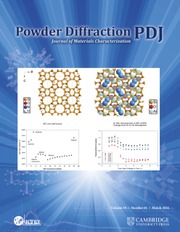Article contents
Validation of an alkali reaction, borate fusion, X-ray fluorescence method for silicon metal
Published online by Cambridge University Press: 01 March 2012
Abstract
The value assignment of candidate Standard Reference Material (SRM®) 57b Silicon Metal provided an opportunity to develop an alkali reaction procedure as a precursor to borate fusion for the preparation of test specimens from the metal powder for X-ray fluorescence spectrometry (XRF). Suggested for this purpose by Blanchette in a 2002 Advances in X-ray Analysis article [45, 415–420 (2002)], the alkali reaction uses LiOH∙H2O to convert Si to Li2SiO3. Lithium silicate is fused with lithium borate flux without damage to platinum ware. Once specimens are fused and cast as beads, calibration standards are prepared to closely match the compositions of the specimens, allowing a linear calibration for each analyte. The XRF method yields results that are directly traceable to the mole through NIST SRM spectrometric solutions. The method was validated in two ways. First, the reaction was used on older SRMs for Si metal: SRM 57 and SRM 57a. Second, XRF results for candidate SRM 57b were compared to results obtained using prompt gamma-ray activation analysis (PGAA) and inductively coupled plasma optical emission spectrometry (ICPOES). Bias tests show the XRF results are accurate for the elements Al, S, Ca, Ti, Cr, Mn, Ni, Cu, and Zr. Levels of S, Ca, Cr, and Cu in candidate SRM 57b are near the limits of quantification of the borate fusion method. Iron results may be subject to a low bias. Phosphorus is not quantitatively retained during the alkali reaction and borate fusion. These elements, plus B, which cannot be determined after borate fusion, are listed in manufacturing specifications for Si metal.
Information
- Type
- X-Ray Fluorescence
- Information
- Copyright
- Copyright © Cambridge University Press 2007
References
- 8
- Cited by

